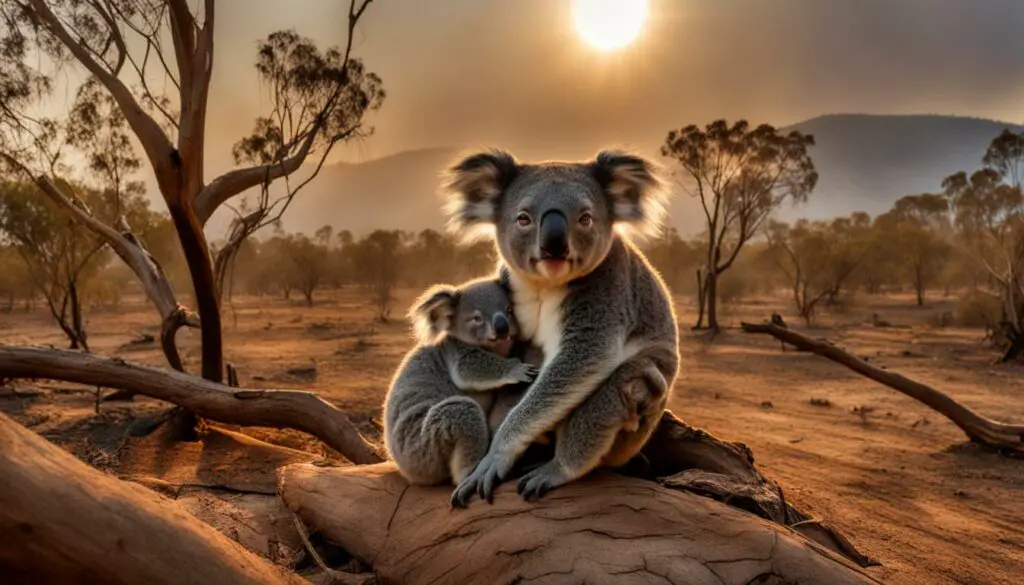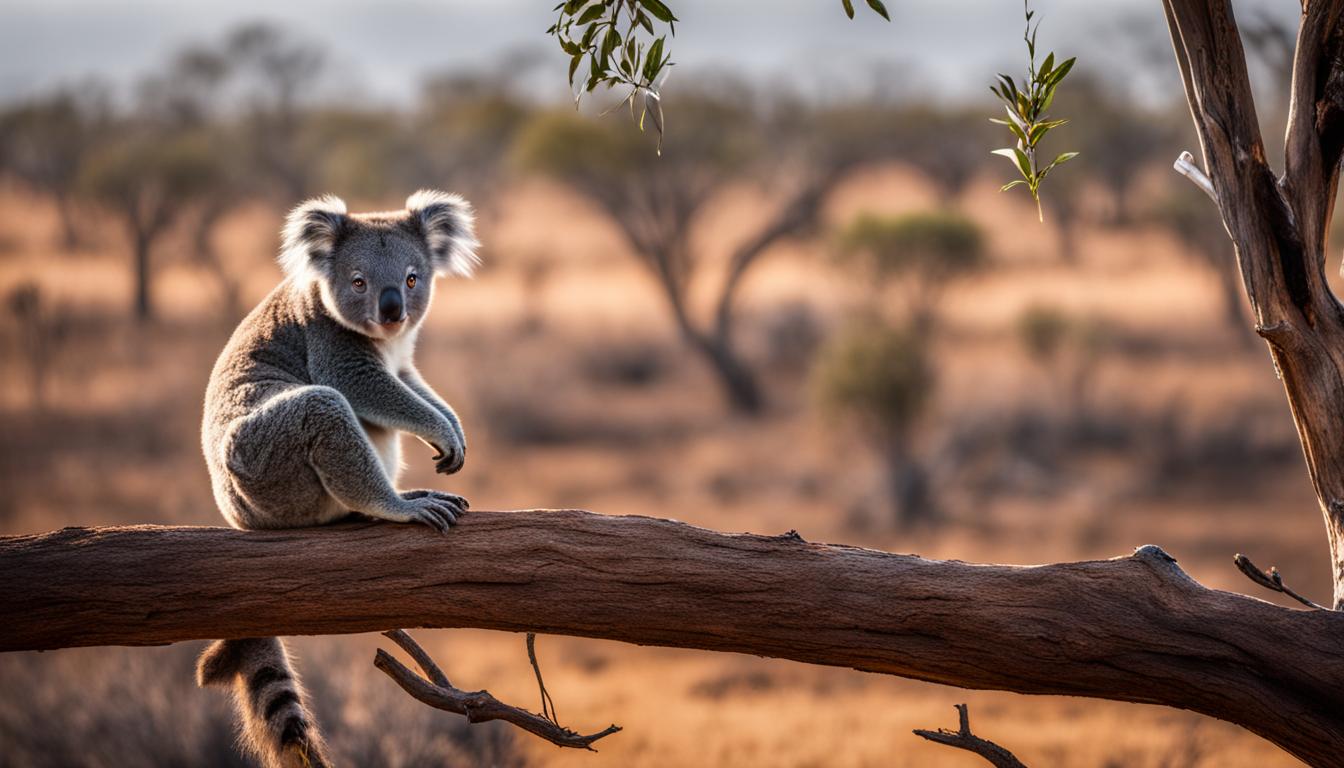Climate change is having a devastating impact on koalas and their habitats. The destruction of koala habitats due to climate change has led to a significant decline in their population. As their food sources are affected by climate change, koalas are facing challenges in finding enough food and water to survive.
With the increasing fragmentation of their habitats, koalas are forced to travel long distances, making them more vulnerable to predators and car accidents. It is crucial to address the issue of koala habitat destruction and take proactive measures to protect these beloved animals.
Koala conservation efforts are essential to ensure the long-term survival of these unique creatures. By raising awareness about the impact of climate change on koalas and their habitats, we can work towards implementing effective conservation strategies.
Stay tuned to learn more about the impact of climate change on koalas and the measures being taken to protect and conserve these iconic Australian animals.
The Impact of Climate Change on Koalas
Climate change has had significant impacts on koalas, endangering their existence and highlighting the urgent need for action. One of the major effects of climate change on koalas is the alteration of their primary food source, eucalyptus trees. Rising temperatures and elevated carbon dioxide levels have led to changes in the chemical composition of the leaves, making them less nutritious for koalas. As a result, koalas now need to eat more leaves to meet their dietary requirements, leading to increased energy expenditure and reduced overall fitness.
Moreover, deforestation driven by human activities and urbanization contributes to habitat loss for koalas. As their habitats shrink, koalas are forced into smaller and more fragmented areas, further increasing their vulnerability to climate change impacts. These habitat changes limit their access to suitable food sources and make them more susceptible to predation and human-related risks such as car accidents.
“The combined effects of climate change and habitat loss pose significant risks to the survival of koalas. Urgent measures are needed to protect their habitats and address the root causes of climate change.” – Wildlife Conservation Society
Table: Impacts of Climate Change on Koalas
| Impact | Description |
|---|---|
| Altered Food Source | Rising temperatures and elevated carbon dioxide levels have reduced the nutritional value of eucalyptus leaves, making it harder for koalas to meet their dietary needs. |
| Habitat Loss | Deforestation and urbanization have led to the loss and fragmentation of koala habitats, diminishing their access to suitable food sources and increasing their vulnerability. |
| Increased Vulnerability | Climate change impacts, combined with habitat loss, have made koalas more susceptible to predation, disease outbreaks, and human-related risks such as car accidents. |
The impacts of climate change on koalas are not only concerning for their population, but also for the overall biodiversity and ecological balance of their habitats. It is crucial for governments, organizations, and individuals to take immediate action to mitigate climate change, restore and protect koala habitats, and ensure the long-term survival of these iconic and cherished creatures.
Koala Breeding and Adaptation in the Face of Climate Change
Climate change presents significant challenges for koala breeding and adaptation. As temperatures rise and the nutritional value of eucalyptus leaves declines, koalas struggle to adapt to changing conditions. These iconic creatures, which already have specialized habitat requirements, find it increasingly difficult to find sufficient food and maintain healthy breeding populations. Additionally, climate change can weaken their immune systems, making them more susceptible to diseases that further hinder successful breeding and adaptation efforts.
The rising temperatures caused by climate change affect the reproductive cycles of koalas. Female koalas can experience reproductive anomalies, leading to reduced fertility rates and decreased breeding success. The changing nutritional composition of eucalyptus leaves, coupled with reduced protein levels, poses further challenges for koalas trying to sustain healthy pregnancies and raise their joeys.
Furthermore, the impact of climate change on koala immune systems cannot be overlooked. As rising temperatures and other environmental stressors weaken their immune responses, koalas become more vulnerable to diseases and infections. This susceptibility to illness can have devastating effects on koala populations, disrupting breeding patterns and hindering their ability to adapt to changing circumstances.
The Importance of Conservation Efforts
In light of the challenges posed by climate change, it is crucial to prioritize conservation efforts to protect koalas and their habitats. Habitat restoration and preservation projects play a vital role in providing suitable environments for breeding and adaptation. Creating wildlife corridors and protected areas can help maintain connectivity between fragmented habitats, allowing koalas to move more freely and access sufficient food resources.
Additionally, international cooperation and commitment to reducing greenhouse gas emissions are essential for safeguarding koalas’ long-term survival. By addressing the root cause of climate change and reducing carbon emissions, we can help mitigate the impacts on koala populations and their ability to adapt to changing conditions.
| Challenges Faced by Koalas in Breeding and Adaptation | Conservation Strategies |
|---|---|
| High temperatures and altered reproductive cycles | Restoring and preserving koala habitats |
| Declining nutritional value of eucalyptus leaves | Creating wildlife corridors for habitat connectivity |
| Weakened immune systems and susceptibility to diseases | Reducing greenhouse gas emissions |
In conclusion, climate change poses significant challenges for koala breeding and adaptation. Rising temperatures, altered food sources, and weakened immune systems all contribute to hindrances in successful reproduction and adaptation. To ensure the long-term survival of koalas, it is imperative to implement conservation strategies focused on habitat restoration, wildlife corridors, and global efforts to reduce greenhouse gas emissions.

Protecting Koalas from Climate Change Impacts
Protecting koalas from the impacts of climate change is a critical endeavor that requires a comprehensive approach. One of the key steps is to restore and create habitats that can support koala populations. By preserving and expanding their natural environments, we can ensure that koalas have sufficient resources to thrive even in the face of changing conditions.
Additionally, it is crucial to address the root cause of climate change itself. Reducing greenhouse gas emissions, particularly from industries such as coal production, is vital in mitigating the effects of climate change on koalas and their habitats. By transitioning to renewable energy sources and implementing sustainable practices, we can significantly reduce the carbon footprint and create a more favorable environment for koalas.
Furthermore, collaboration between various stakeholders is essential in protecting koalas from climate change impacts. Governments, conservation organizations, and the public must work together to implement conservation strategies, enforce regulations, and raise awareness about the importance of preserving koala habitats. By fostering international cooperation and shared responsibility, we can ensure a better future for koalas and other vulnerable species.
The importance of community involvement
Engaging local communities in koala conservation efforts is crucial. Individuals and communities can contribute in various ways, such as planting native trees, maintaining wildlife corridors, and reporting koala sightings or habitat destruction. By involving the community, we can create a sense of ownership and responsibility towards koalas and their habitats, leading to more effective conservation outcomes.
| Ways to protect koalas from climate change impacts | Benefits |
|---|---|
| Restoring and creating habitats | Provides koalas with sufficient resources |
| Reducing greenhouse gas emissions | Mitigates the effects of climate change |
| Collaboration and community involvement | Creates shared responsibility and effective conservation outcomes |
Protecting koalas from climate change impacts is not a single solution but a collective effort. By implementing these measures and fostering global cooperation, we can safeguard the future of koalas and ensure their survival in a changing world.
Koala Conservation Efforts and Future Outlook
Koala conservation efforts play a vital role in safeguarding these iconic creatures from the impacts of climate change. Various initiatives and strategies are being implemented to protect koalas and their habitats, ensuring their long-term survival and contributing to overall biodiversity conservation.
One of the key aspects of koala conservation is raising awareness about their plight and the importance of preserving their habitats. Public education campaigns, both locally and internationally, help to highlight the critical role koalas play in the ecosystem and the need for their protection. By promoting a deeper understanding of the challenges koalas face, we can garner support for conservation efforts and drive positive change.
Another crucial component of koala conservation is habitat protection. Establishing protected areas and wildlife corridors allows koalas to move freely, access food and water resources, and maintain genetic diversity. These conservation measures help to mitigate the negative effects of fragmentation and provide safe havens for koalas to thrive.
| Conservation Strategies | Description |
|---|---|
| Restoring degraded habitats | Efforts to rehabilitate and restore koala habitats, ensuring the availability of suitable food sources and safe living environments. |
| Collaborative research and monitoring | Partnerships between scientists, conservation organizations, and government agencies for data collection, monitoring of koala populations, and research on their behavior and adaptation to changing environments. |
| Conservation breeding programs | Initiatives to establish captive breeding programs that aim to increase koala populations, enhance genetic diversity, and mitigate the risks of extinction. |
| Conservation land management | Implementing sustainable land management practices that prioritize koala habitats, reduce threats from urbanization and deforestation, and promote conservation-friendly practices. |
Moreover, international cooperation is crucial for the long-term survival of koalas. Addressing climate change requires global efforts to reduce greenhouse gas emissions, protect natural habitats, and promote sustainable practices. By working together, countries can share expertise, resources, and best practices to ensure a brighter future for koalas and other vulnerable species.
In conclusion, koala conservation efforts are essential in mitigating the impacts of climate change on these beloved creatures. Through public awareness, habitat protection, collaborative research, and international cooperation, we can create a sustainable future where koalas can thrive and continue to enchant us with their unique presence.
Conclusion
Koalas are facing significant threats due to climate change, which has a direct impact on their food sources, habitats, and overall well-being. To protect these beloved creatures from the detrimental impacts of climate change, urgent action is required.
The key to safeguarding koalas from climate change lies in addressing the root cause by reducing greenhouse gas emissions. This necessitates a collective effort to mitigate climate change on a global scale.
Conservation efforts are essential in ensuring the survival of koalas in a changing climate. By raising awareness, protecting their habitats, and creating wildlife corridors, we can contribute to the preservation of these iconic marsupials.
International cooperation is crucial in this endeavor. By joining hands and committing to reducing greenhouse gas emissions, we can pave the way for a future where koalas can adapt, thrive, and continue to enchant us for generations to come.
What are the Similarities and Differences in the Impact of Climate Change on Giraffes and Koalas in Their Habitats?
The impact of climate change on giraffe habitats and climate change is a pressing concern. Both giraffes and koalas are facing challenges due to shifting weather patterns and habitat loss. However, the specifics differ. Giraffes, with their ability to adapt to different environments, may withstand the changes better. In contrast, koalas heavily rely on specific eucalyptus forests, making them more susceptible to habitat destruction and food scarcity. Understanding these similarities and differences is crucial in implementing effective conservation strategies.
FAQ
How does climate change affect koalas in their habitats?
Climate change impacts koalas by affecting the composition of their primary food source, eucalyptus leaves, making them less nutritious and providing fewer water resources. This leads to food and water scarcity, increasing the vulnerability of koalas to predators and car accidents.
What are the main threats to koalas caused by climate change?
Koalas face threats from wildfires, disease outbreaks, and elevated carbon dioxide levels impacting their primary food source, eucalyptus trees. Deforestation, driven by urbanization and contributing to climate change, also poses a significant threat to koala habitats.
How does climate change affect koala breeding and adaptation?
Rising temperatures and reduced protein levels in eucalyptus leaves make it challenging for koalas to adapt. The changing climate also weakens koala immune systems, making them more susceptible to diseases, hindering successful breeding and adaptation efforts.
What measures can be taken to protect koalas from climate change impacts?
Comprehensive measures include restoring and creating new habitats, but it is crucial to address the root cause of climate change by reducing greenhouse gas emissions, particularly from coal. Climate change mitigation strategies must be prioritized by the Australian government to ensure the long-term survival of koalas.
What efforts are being made for koala conservation in the face of climate change?
Koala conservation efforts involve awareness campaigns, habitat protection, and the establishment of wildlife corridors. International cooperation and commitment to reducing greenhouse gas emissions are also essential for the long-term survival and thriving of koalas.











